| Controller Type | Example pic | Products | Capability | (+) Pro | (-) Con |
| External or internal Sync Doubler | 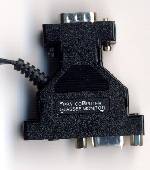
Neotek Model SS |
professional products by
Stereographics, Neotek,
NuVision and others,
some pro-graphics boards & workstations |
turns split screen into kind of page- flipping | stereo-orientation remains
stable,
perfect compatibility to any graphics hardware, 100% VGA-chipset independent, NO driver software required, high refresh rates by default, easy setup, lots of prof. software, standard video codec (mpeg, avi,...) compatible |
expensive (H3D is an exception),
lack of split screen consumer software (H3D might change that), always half resolution, some lines are lost for the retrace gap, pass-through-cable might deteriorate VGA-signal (*) |
| VGA-pass-through with general V-sync detection | 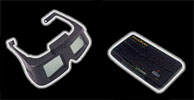
i-Art |
i-Art
Virtual Eyes,
APEC-VR97, Cyberstuff Cyber3DVisor(?), Homebrew VGA-PT |
syncs to all interlace and page-flipping screens | almost perfect hard- and software compatibility, easy setup, stereo reverse button, Windows support, little impact on CPU | stereo- orientation can flip very often in some cases, orientation has to be set manually each time, drivers required, pass-through-cable might deteriorate VGA-signal (*) |
| VGA-pass-through with general V-sync detection and line-blanker | 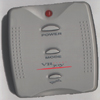
VR-Joy |
VR-Joy
CyberboyII (?) EyeFX |
syncs to all interlace and page-flipping screens, creates artificial interlace on any graphics board | perfect hardware- and almost perfect software compatibility, easy setup, stereo reverse button, Windows support, little impact on CPU, no drivers required | stereo- orientation can flip very often in some cases, orientation has to be set manually each time, pass-through-cable might deteriorate VGA-signal (*) |
| VGA-pass-through with tweaked V-sync detection | 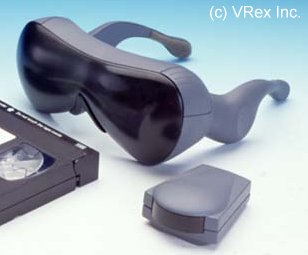
VR-Surfer |
VRex VRSurfer | syncs to all interlace signals, (page-flipping limited) | stereo-orientation remains
stable,
auto-shut-off, high refresh rates easy to achieve, Windows support, reverse button, good software compatibility (next to VGA-pass-through), little impact on CPU, good results even on low-end monitors |
VGA chipset dependend driver, no Rendition, 3DFX or other newer chipsets supported, limited page-flipping support, no line doubling, pass-through-cable might deteriorate VGA-signal (*) |
| VGA-pass-through with sync detection, sync doubler and line blanker (synthetic interlace), controled by proprietary code pattern | 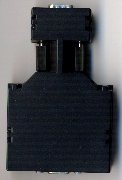
H3D |
H3D Eyewear | turns split screen into page-flipping, turns standard into "synthetic interlace", syncs to page-flipping | stereo-orientation remains stable, perfect compatibility to any graphics hardware, 100% VGA-chipset independent, NO driver software required, combines the advantages of sync doubler and sync detection controllers (except for software compatibility), unique "synthetic interlace", easy setup when used with native software | no backward software compatibility whatsoever, no support for non-H3D-certified software, requires H3D code pattern, no manual overrides, pass-through-box might deteriorate VGA-signal (*) |
| VGA-pass-through with White Line Code detection | 
SimulEyes |
Stereographics-SimulEyes, miro-3D-fanatix | syncs to all interlace and page-flipping signals as long as White Line Code is present | stereo-orientation remains
stable,
easy setup, no stereo reverse needed, Windows support, little impact on CPU |
works with proprietary software only, WLC must stay on the screen all the time, pass-through-cable might deteriorate VGA-signal (*) |
| serial/parallel port | 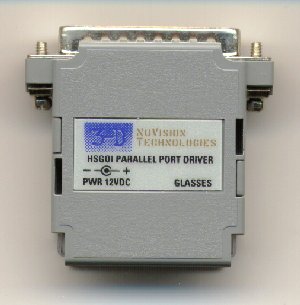 |
Nuvision-3D-SPEX,
Woobo-Cyberboy, APEC-Virtual Visor, 3DTV-3D-Magic, Chinon-Cybershades,
homebrew-controller |
syncs to page-flipping, requires control software | stereo-orientation remains
stable,
no pass-through cable in the way of the VGA-signal [3D-SPEX supports Windows (not on Cyrix machines) and most DOS software, Cyberboy hasa stereo reverse button] |
synchronization must be achieved by software, possible sync errors, impact on CPU, no interlace mode support, no Windows support (except limited support for 3D-SPEX & compatibles --WinSPEX !!!!), one serial or parallel port used (some products have a pass-through parallel solution) |
| 3D-Max ISA card/on-board controller | 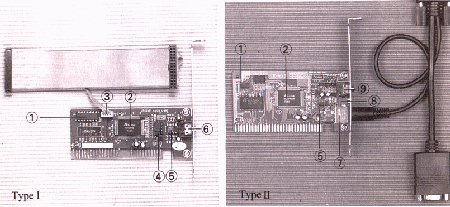 |
Kasan-3D-Max,
Kasan VGA cards with on-board controller,
(Russian Shield Stereo Set?) |
syncs to Interlace, must be invoked by software | stereo-orientation remains
stable,
high refresh rates easy to achieve, Windows support, good software compatibility (next to VGA-pass-through, even better in some rare cases), little impact on CPU, good results even on low-end monitors |
VGA chipset dependend driver, no Matrox, Rendition, 3DFX or other new chipsets supported, no page-flipping support (?), eats up an ISA slot, no line doubling, pass-through-cable might deteriorate VGA-signal (*) |
| (Canopus T3D) on-board controller | 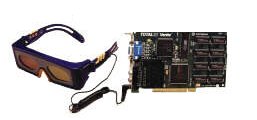 |
Canopus Total 3D | syncs to RAM-DAC (page-flipping) | stereo-orientation remains stable (?), no pass-through cable in the way of the VGA-signal | limited software compatibility (???), no interlace mode support, no Windows support (?) |
| (VESA) miniDIN-3 on-board connector (additional external controller circuitry required) | 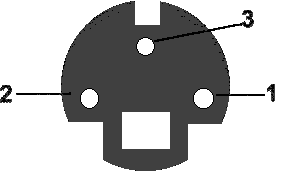 |
Glasses: StereoGraphics
CrystalEyes, Z-Screen;
VGA-boards: Hercules Thriller, Hercules Stingray 128, Diamond Fire GL 1000 pro, dsystems GLadiator and more |
syncs to RAM-DAC (page-flipping) | professional solution, standard of the future, stereo-orientation remains stable, no impact on CPU time, no pass-through cable in the way of the VGA-signal | not much consumer software support yet, no consumer glasses yet, doesn't drive glasses directly - additional controller circuitry required |
